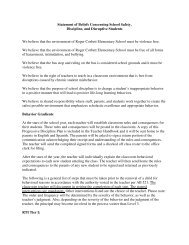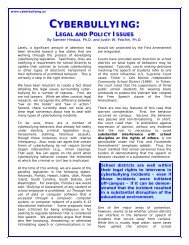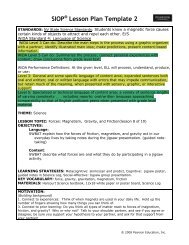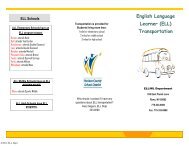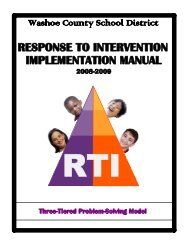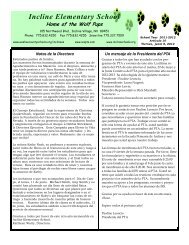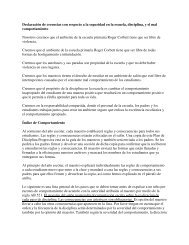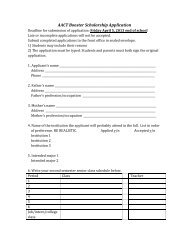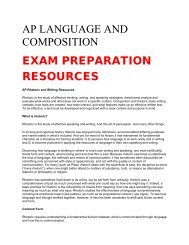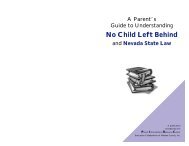Sample School Safety Plan Development Templates
Sample School Safety Plan Development Templates
Sample School Safety Plan Development Templates
Create successful ePaper yourself
Turn your PDF publications into a flip-book with our unique Google optimized e-Paper software.
Safe Havens International presents:<strong>Sample</strong> <strong>School</strong> <strong>Safety</strong> <strong>Plan</strong> <strong>Development</strong> <strong>Templates</strong>All materials contained in this sample are copyrighted and may not be reproduced without expresswritten permission from Safe Havens International.©2005 Safe Havens International Inc.Terms of Use AgreementBy purchasing the <strong>School</strong> <strong>Safety</strong> <strong>Plan</strong> <strong>Development</strong> <strong>Templates</strong>, the client agrees to the terms as set forthin the Terms of Use Agreement. For the purposes of this document, the term “client” refers to any userwho downloads this file.CopyrightSafe Havens International Inc. retains the copyright to all material delivered to the client.Permitted UsesThe client has unlimited reproduction and distribution rights within its organization for additional trainingand presentation to other staff only. The client may modify, change, alter, or otherwise tailor the templatesto fit its organization’s needs.Prohibited UsesThe client is prohibited from sharing, trading, selling, or otherwise making the templates available, eitherin modified or unmodified form, to outside organizations, systems, or individuals. None of the materialmay be disclosed, including images, to a third party without explicit written permission from Safe HavensInternational Inc. It is the responsibility of the client to ensure that the templates are used in accordancewith the Terms of Use Agreement.LiabilitySafe Havens International Inc. provides these sample pages for the client to use for evaluation of the valueof the overall set of templates. These sample pages should not be used to create or add to a fully integratedlocal emergency operations plan without the full set of templates. The sample and the templates are in noway designed as a substitute for consultation by qualified public safety and emergency managementofficials. The templates are designed as a starting point to assist school and emergency response officialsin the development of a customized school safety plan that is appropriate to address local risks andresources. Safe Havens International make no claim in regards to the accuracy or validity of the materialsor information provided and have no liability in respect to such materials or information or any actionsarising from their use.
About the <strong>Templates</strong>The school safety plan development templates are designed to allow school officials to workclosely with local emergency response and community service officials to develop a custom fourphase all hazards school safety plan as recommended by the United States Department ofEducation and Jane’s Information Group.Portions of the templates were tested by several client districts who were recipients of UnitedStates Department of Education crisis planning grants. Preliminary tests by these school systemsindicate that the templates allow school and local public safety and public service officials todevelop a customized four phase plan with about a 75% reduction in the time and effort required.Evaluators also reported that the plan sections they developed using the templates were also ofmuch higher quality.The full package of school safety plan development templates, which is over 300 pages long,includes:• A user guide.• A prevention and mitigation plan development template.• Response plan templates including master response protocols. Includes integrated flip chartsfor a variety of categories of employees including lead administrator/crisis response teammembers, transportation personnel, faculty/staff, custodians and an after hours event flipchart. Each flip chart template is derived from and integrated with the master protocols. Alsoincludes 14 different logs and tracking sheet template.• A recovery plan template: The United States Department of Education and top recoveryexperts including Marleen Wong recommend that districts develop a recovery plan and trainstaff in its use.• A tactical site survey checklist template• An exercise package for planning and conducting emergency drills and exercises using aprogressive exercise program as recommended by the United States Department of Education,the Federal Emergency Management Agency and Jane’s. The exercise package includes morethan thirty drills, tabletop exercises and functional exercises complete with messaging slips.The package also includes a variety of exercise design and evaluation forms and checklists.This section will enable a district with an aggressive exercise program to conduct one drill perschool month for three years without repeating a scenario.• Survey and feedback forms for staff, students, and parents.
Included in this sample are some excerpts from the templates that should provide a strong idea ofthe comprehensive nature of the templates and their ability to assist a district with thedevelopment of a complete crisis plan. There are 15 different sample sections included in thisdocument.<strong>Sample</strong> DescriptionPage1. Section from the Prevention/Mitigation <strong>Plan</strong> Template ............................................. 42. Functional Protocol: Remote Evacuation and Family Reunification ......................... 63. Incident Specific Protocol: Bomb Threats/Suspicious Packages................................ 74. Lead Administrator/Crisis Response Team Member: Remote Evacuation and FamilyReunification Protocol .................................................................................................. 105. Transportation Flip Chart: Remote Evacuation and Family Reunification Protocol 116. Faculty/Staff Flip Chart: Remote Evacuation and Family Reunification Protocol .. 137. Custodian’s Flip Chart: Remote Evacuation and Family Reunification Protocol .... 148. After Hours Activities Flip Chart: Remote Evacuation and Family Reunification Protocol....................................................................................................................................... 159. Response <strong>Plan</strong> <strong>Templates</strong>: Incident Tracking Sheet................................................. 1610. Recovery <strong>Plan</strong> <strong>Templates</strong>: Death Notification Protocol......................................... 1811. Section from Comprehensive Tactical Site Survey Template ................................ 2012. <strong>Sample</strong> Items from the Exercise Package............................................................... 2213. <strong>Sample</strong> Questions for Participants to Use in Functional Exercises ........................ 2514. <strong>Sample</strong> Exercise Checklists: Emergency Programs ............................................... 26If you are interested in the templates for your district or state, please contact Safe HavensInternational to discuss pricing and package offers.Safe Havens International, Inc.An IRS approved non-profit<strong>School</strong> & Community <strong>Safety</strong> Center1458 Conestoga TrailMacon, Georgia, 31220(404) 557-2068www.safehavensinternational.orgchris@weakfish.org
1. Section from the Prevention/Mitigation <strong>Plan</strong> TemplateE. Interior Physical Security and <strong>Safety</strong> Measures1. Security cameras provide coverage for key indoor areas at all middle and high schools.2. All school lockers are kept locked at all times, and students are required to use schoollocks.3. The school system has established a procedure for random locker inspections to deterstudents from keeping weapons in lockers.4. The school system has established a random metal detection policy. Random metaldetection screening is conducted at each middle and high school several times each year.5. Drug and bomb detection dogs are utilized several times each year to check studentlockers and public areas for drugs, firearms, and explosive devices as a deterrentmeasure.6. The number of trash containers in use in each school has been minimized. Trashcontainers are not situated in areas that are out of view. This has been done to reduce thenumber of potential hiding places for explosive devices and contraband.7. All schools require that students and school employees wear standardized identificationbadges with a photograph.8. All schools have a visitor badge system in place.9. Each school tests all fire alarm pull stations twice each year to ensure that they functionproperly.10. Fire department fire prevention bureau personnel conduct a fire prevention seminar forthe staff at each school and facility once annually. Topics include the proper use of fireextinguishers, fire evacuation procedures, common fire code violations in schools, andspecial concerns for cafeteria personnel.11. Each school tests the building intrusion alarm system twice each year.12. The police department crime prevention bureau conducts a crime prevention seminar forstaff at each school and facility once annually.13. Each school has taken steps to properly secure all desktop computers, VCR’s andtelevision sets. Security measures include steps to secure computers against theft andunauthorized access.14. All television sets that are not wall mounted are either bolted to carts or secured usingsafety straps. District policy prohibits students from being used to move television carts15. Each school has developed a system to ensure that rooms that are not in use are keptlocked.16. The district has a system in place to ensure that serial numbers are on file for schoolsystem property.17. Valuable school property has been clearly marked to identify it as school property.18. Each school has established a system to locate, photograph, remove, and report all graffitito law enforcement in a timely manner.19. The district uses an internet filtering system. These filtering systems prevent access tosites containing pornography, hate groups, and sites relating to weapon and bomb makingmaterials. The filters are tested through use to make sure they work while not blockingsites needed by students for schoolwork.20. Each school has developed a system to restrict access to the building during the day bykeeping specified doors locked when not in use.
21. Every school has a designated room that is heavily secured. High value equipment ismoved to these rooms for storage during extended holidays and summer breaks.22. The district safety design team has conducted a CPTED (crime prevention throughenvironmental design) and target hardening assessment of each school and facility.Changes have been made as appropriate based on the team’s recommendations. Teammembers have received formal training on CPTED.23. The district safety design team evaluates all building construction and renovation plansearly in the design process and makes recommendations to enhance the level of safetythrough design features (CPTED and target hardening).24. Local emergency management, fire service and law enforcement officials have anopportunity to review building construction and renovation plans early in the designprocess. These officials are afforded an opportunity to make comments on safety andemergency management concerns.25. The district requires that the architectural firm awarded a building construction orrenovation project must have at least one CPTED-trained design team member.
2. Functional Protocol: Remote Evacuation and FamilyReunificationDefinitionThis type of evacuation is used for any evacuation where students and staff will need to bemoved to a remote site for reunification with family members and loved ones.Alert SignalAnnouncement over the public address system “All staff initiate a Code Blue – emergencyevacuation in effect at this time, evacuate to site __________________located at____________________. Please sweep all routes and the site. We will be implementing theRemote Evacuation and Family Reunification Protocol from that location”Lead administrator Response1. Notify the central office of your decision to implement the family reunification protocol.Provide a brief description of the incident and specify the staging area so buses can bedispatched to the appropriate location.2. Request that law enforcement officials dispatch uniformed personnel to the staging area.3. Activate appropriate crisis teams.4. Make the announcement by public address system, runners, e-mail or whichever means ismost practical “All staff initiate a Code Blue – emergency evacuation in effect at this time,evacuate to site __________________located at ____________________. Please sweep allroutes and the site. We will be implementing the Remote Evacuation and FamilyReunification Protocol from that location”5. In certain situations, it may not be practical or safe to order a general evacuation (such asduring a hostage situation or if an armed intruder may still be in the area). In such instances,coordinate with public safety officials for law enforcement officials to conduct theevacuation room by room.6. Designate a staff member to serve as your representative at the family reunification center.Instruct them to take student information from one of the Emergency Evacuation Kits withthem.7. Notify the appropriate crisis team member to serve as your representative at the staging area.Staff Response1. Follow non-fire evacuation procedures and guide students to the designated on campusevacuation site. Prepare students for boarding of buses.2. Ensure that any special needs persons in your area of responsibility are assisted during theevacuation.3. Once students and other persons from your area of responsibility have boarded a bus, assistthe bus driver by taking roll and completing the driver’s evacuation roster.4. Follow the instructions of Family Reunification Staff when you arrive at the FamilyReunification Site. You may be asked to assist in staffing the site.
3. Incident Specific Protocol: Bomb Threats/Suspicious PackagesDefinitionA bomb threat/suspicious package situation is one that involves the threat of an explosive devicethat has been placed in, around, or near a facility ,or the detection of a suspicious package thatcould contain an explosive device.Alert SignalAnnouncement over the public address system “All staff initiate a Code Blue – emergencyevacuation in effect at this time, evacuate to site __________________located at____________________. Please sweep all routes and the site.”Or;“All staff initiate a sweep in place, please report your status upon completion of the sweep”Lead administrator ResponseUpon receipt of a bomb threat, the lead administrator should call 911 and request that fire, lawenforcement and emergency management personnel respond. If a threat has been received byphone, provide the completed bomb threat checklist (see Appendix A) to the first lawenforcement officer to arrive on the scene. Make sure that call tracing procedures have beenimplemented (keep the phone that the call was received on off the hook so that the call can betraced – if another call comes in afterward this is no longer possible). Consult with respondingpublic safety officials and quickly determine whether it is best under the circumstances to sweep,evacuate and search or to sweep in place. Available information should be evaluated to weigh thepotential risks of explosive devices inside the building, explosives devices outside the building(including the possibility of a vehicle bomb), explosives devices placed in or near evacuationroutes or sites or other hazards such as persons with firearms who plan to shoot at evacuees. Ifmultiple bomb threats are received over time, be sure to rotate evacuation routes and sites tomake it more difficult for someone to pattern your evacuation responses and target evacuees withexplosives, firearms or chemical agents.If the sweep and evacuate option is selected:1. Notify staff to sweep and evacuate make public address announcement: “All staff initiate aCode Blue – emergency evacuation in effect at this time, evacuate to site__________________located at ____________________. Please sweep all routes and thesite.” If multiple threats are received over a relatively short time period, be sure to rotateevacuation routes and sites.2. Have the evacuation route and site swept for suspicious persons, objects (which couldcontain an explosive device) or other safety hazards prior to the evacuation if appropriate.3. Have designated staff or public safety officials direct students safely across any streets thatmust be crossed by evacuees.4. Remind staff members and students not to utilize cellular or digital phones or portable radiosunless a life-threatening emergency exists.
5. Request that uniformed personnel escort staff and students to the evacuation site and remainwith them until and unless they are instructed to return to the building.6. Leave the facility and take the emergency evacuation kit and make responding public safetyofficials aware of the contents of the kit.7. Check with staff to see that all evacuees are accounted for. Immediately notify respondingpublic safety officials if any persons are not accounted for.8. Assist responding public safety officials with the second sweep of the facility.9. Consult with public safety officials before authorizing evacuees to return to the facility.10. You may determine that it is appropriate to close the facility for the remainder of the day. Ifso, begin notification of parents and guardians and implement your emergency releaseprocedures.If the sweep and remain in place option is selected:1. Make intercom announcement: “All staff initiate a sweep in place, please report your statusupon completion of the sweep.”2. Escort public safety officials through the building to verify that all areas have been swept bystaff. Make sure that all areas inside and around the facility have been swept.3. Assist public safety officials in conducting the second sweep of the facility.4. If any suspicious packages are noted by staff or public safety officials, make sure that allstaff and students are moved away from the item and that it is not disturbed in any way.5. Consult with public safety officials to see if the facility should be evacuated, if the decision ismade to do so, implement the Non-Fire evacuation plan.Staff ResponseSweep and evacuate procedures:1. If the sweep and evacuate option is announced, staff should quickly scan their area ofresponsibility for any packages or items that could contain an explosive device (objects thatthey do not recognize as normally being present).2. If no such items are noted, staff should use masking or duct tape to make a slash across theentrance door to the area (/) to indicate to public safety officials they have swept the area andno suspicious items were noticed.3. If any suspicious items are noted, they should not be disturbed and the staff member shouldnotify the lead administrator or designee upon evacuation from the area.4. The staff member should then follow the non-fire evacuation protocol. Have students bringtheir book bags and other hand carried articles with them.5. Refrain from using cellular or digital telephones or portable radios during these situationsunless a life-threatening emergency exists. In some extremely rare instances, radio frequencyenergy can trigger an explosive device to detonate. Explain to students that any electroniccommunication devices that are observed in use will be seized. Explain to the students thatthe use of such devices can pose a safety hazard.Sweep and remain in place procedures:
1. Staff members should scan their area of responsibility for any packages or items that couldcontain an explosive device (objects that they do not recognize as normally being present).2. If no such items are noted, staff should make a slash with masking or duct tape across theentrance door to the area (/) to indicate to public safety officials that they have swept the areaand no suspicious items were noted. Take a roll to account for all persons in your area ofresponsibility in case evacuation is ordered at a later time.3. If any suspicious items are noted, they should not be disturbed. The staff member should thendirect all people in the area to follow them to the lead administrator’s office and inform thelead administrator or designee of his or her observations.4. Follow the lead administrator’s instructions.
4. Lead Administrator/Crisis Response Team Member: RemoteEvacuation and Family Reunification ProtocolDefinitionThis type of evacuation is used for any situation in which students and staff need to be moved toa remote site for reunification with family members and loved ones.Alert SignalAnnounce over the public address system “All staff initiate a Code Blue – emergency evacuationin effect at this time, evacuate to site __________________located at ____________________.Please sweep all routes and the site. We will be implementing the Remote Evacuation andFamily Reunification Protocol from that location”Lead administrator Response1. Notify the central office of your decision to implement the family reunification protocol.Provide a brief description of the incident and specify the staging area so that buses can bedispatched to the appropriate location.2. Request that law enforcement officials dispatch uniformed personnel to the staging area.3. Activate appropriate crisis teams.4. Make the announcement by public address system, runners, e-mail or whichever means ismost practical “All staff initiate a Code Blue – emergency evacuation in effect at this time,evacuate to site __________________located at ____________________. Please sweep allroutes and the site. We will be implementing the Remote Evacuation and FamilyReunification Protocol from that location”5. In certain situations, it may not be practical or safe to order a general evacuation (such asduring a hostage situation or if an armed intruder may still be in the area). In such instances,coordinate with public safety officials for law enforcement personnel to conduct theevacuation room by room.6. Designate a staff member to serve as your representative at the family reunification center.Instruct him or her to take along student information from one of the Emergency EvacuationKits.7. Notify the appropriate crisis team member to serve as your representative at the staging area.
5. Transportation Flip Chart: Remote Evacuation and FamilyReunification ProtocolDefinitionThis type of evacuation is used for any evacuation where students and staff will need to bemoved to a remote site for reunification with family members and loved ones. Transportationpersonnel need to be familiar with two very different scenarios for this protocol, relocation froman affected school, and relocation from an affected bus.Alert SignalNotification by dispatcher or in person notification by route supervisorDriver ResponseFor an incident involving your bus:1. Follow non-fire evacuation procedures and guide students to an appropriate evacuation site.Prepare students to board another bus.2. Ensure that any special needs persons are assisted during the evacuation.3. Once students have boarded a bus, assist the bus driver by taking roll and completing thedriver’s evacuation roster.4. Follow the instructions of Family Reunification Staff when you arrive at the FamilyReunification Site. You may be asked to assist in staffing the site.Route Supervisor Response1. Notify dispatch and the central office of your decision to implement the family reunificationprotocol. Provide a brief description of the incident and specify the staging area so a bus canbe dispatched to the appropriate location.2. Request that law enforcement officials dispatch uniformed personnel to the staging area.3. If you must stay at the scene, designate a staff member to serve as your representative at thefamily reunification center.When one or more schools are affected by a crisisDriver Response1. When you are notified that your assistance is needed for implementation of the familyreunification plan, make sure that you have copies of student family reunification rosters.2. Follow directions provided by route supervisors and public safety officials as to the bestapproach to the affected school or its evacuation area.3. Try to calm students as they board the bus.4. Once loaded, proceed safely to the family reunification site. Understand that evacuees maybe traumatized by events and may be in an excited and emotionally distraught state.5. Have a staff member fill out the student transport roster. If no staff member is present, ask astudent to perform this task and note the name of the student who completed this task on theform.6. Do not stop the bus or open the door to allow evacuees to meet family members.
7. When you arrive at the family reunification site, follow the instructions of public safety andcrisis team personnel. Provide the roster(s) to the Crisis team member that meets your bus.8. Return for the next relay if you are needed and repeat the process until the evacuation iscomplete.9. Your bus may or may not be escorted by law enforcement depending on the availableresources and the nature of the crisis.10. Keep all radio traffic to a minimum.Supervisor Response1. Advise all drivers to keep the radio clear except for important transmissions until the lasttransport is completed.2. Work with administrators at the affected site, crisis response team members and public safetyofficials to set up an efficient relay system. Designate a staging area near the school so busescan be staged there if too many buses arrive at the evacuation area at one time for loading.3. Maintain a log of the status of all involved buses to help you keep track of availableresources.4. If buses from another school system or mass transit buses are sent to assist, coordinate withtheir supervisors and personnel. Attempt to establish a means of radio communications withtheir personnel. You may be able to provide a spare radio to a representative of theirorganization.5. Brief your supervisor as appropriate.
6. Faculty/Staff Flip Chart: Remote Evacuation and FamilyReunification ProtocolDefinitionThis type of evacuation is used for any evacuation where students and staff will need to bemoved to a remote site for reunification with family members and loved ones.Alert SignalAnnouncement over the public address system “All staff initiate a Code Blue – emergencyevacuation in effect at this time, evacuate to site __________________located at____________________. Please sweep all routes and the site. We will be implementing theRemote Evacuation and Family Reunification Protocol from that location”Teacher Response1. Follow non-fire evacuation procedures and guide students to the designated on campusevacuation site. Prepare students for boarding of buses.2. Ensure that any special needs persons in your area of responsibility are assisted during theevacuation.3. Once students and other persons from your area of responsibility have boarded a bus, assistthe bus driver by taking roll and completing the driver’s evacuation roster.4. Follow the instructions of Family Reunification Staff when you arrive at the FamilyReunification Site. You may be asked to assist in staffing the site.
7. Custodian’s Flip Chart: Remote Evacuation and FamilyReunification ProtocolDefinitionThis type of evacuation is used for any evacuation where students and staff will need to bemoved to a remote site for reunification with family members and loved ones.Alert SignalAnnouncement over the public address system “All staff initiate a Code Blue – emergencyevacuation in effect at this time, evacuate to site __________________located at____________________. Please sweep all routes and the site. We will be implementing theRemote Evacuation and Family Reunification Protocol from that location”Custodial Response1. Follow non-fire evacuation procedures and guide students to the designated on campusevacuation site. Prepare students for boarding of buses.2. Ensure that any special needs persons in your area of responsibility are assisted during theevacuation.3. Report to the lead administrator/staff member/Crisis Response Team member and provideassistance as needed. Assistance may include:4. Aiding Crisis Response Team members in sweeping all or part of the facility to ensure thatall occupants are evacuated.5. Aiding Crisis Response Team members in securing the facility.6. Once you are advised to evacuate to the family reunification site and students and otherpersons from your area of responsibility have boarded a bus, assist the bus driver by takingroll and completing the driver’s evacuation roster.7. Follow the instructions of Family Reunification Staff when you arrive at the FamilyReunification Site. You may be asked to assist in staffing the site.
8. After Hours Activities Flip Chart: Remote Evacuation andFamily Reunification ProtocolDefinitionThis type of evacuation is used for any evacuation where students and staff will need to bemoved to a remote site for reunification with family members and loved ones.Alert SignalAnnouncement over the public address system, bullhorn, or other means “We are activating ourFamily Reunification protocol. Students, staff and visitors will be transported to__________________________ to be reunited with their loved ones.We ask for your assistance and cooperation. Buses will pick us up at ___________All staff initiate a Code Blue – emergency evacuation in effect at this time, evacuate to site__________________located at ____________________. Please sweep all routes and the site.We will be implementing the Remote Evacuation and Family Reunification Protocol from thatlocation”Lead Staff Member Response1. Coordinate with public safety officials and/or Crisis Response Team members when decidingwhich site to use. Unlike a daytime emergency, another school or athletic stadium may beappropriate.2. Notify ________________ of your decision to implement the family reunification protocoland request that the Crisis Response Team be activated and sent to the selected site. Requestthat Crisis Response Team members have someone dispatched to the selected site withmaster keys. Provide a brief description of the incident and specify the staging area so busescan be dispatched to the appropriate location.3. Request that law enforcement officials dispatch uniformed personnel to the staging area.4. Make the announcement by public address system, runners, e-mail or by the most practicalmeans available to inform visitors, staff and students. It may be best to wait until the CrisisResponse Team and buses have had time to travel to the affected site and the familyreunification site before making the announcement and moving to the staging area.5. In certain situations, it may not be practical or safe to order a general evacuation (such asduring a hostage situation or if an armed intruder may still be in the area). In such instances,coordinate with public safety officials for law enforcement officials to conduct theevacuation room by room.6. Designate a Crisis Response Team member or other staff member to serve as yourrepresentative at the family reunification center. Instruct them to take student informationfrom one of the Emergency Evacuation Kits with them.7. Notify the appropriate crisis team member to serve as your representative at the staging area.
9. Response <strong>Plan</strong> <strong>Templates</strong>: Incident Tracking SheetUse official command post time. Please use ink.Location of Incident:Type of incident: BOMB THREAT/NON-FIRE EVACUATIONSheet initiated by:Date:1 st ShiftRelieved by:Time:2 nd ShiftRelieved by:Time:3 rd ShiftRelieved by:TimeACTION ORGANIZATION STATUS NOTES REPORTED BYNotify appropriate publicsafety (police, fire)Select an evacuation routeand siteActivate appropriate crisisteamsSend designated staffmember(s) to sweep theevacuation route and siteAnnounce evacuationSweep the facility forstudents and adults, assistspecial needs personsEnsure that the emergencyevacuation kits are removedfrom the buildingEvacuate according to nonfireevacuation protocolReport to the firstresponding public safetyofficialReport to the evacuationsite
Decide whether toimplement the familyreunification protocolImplement the mediaprotocolOnce at the site, develop awritten list of all evacueesConfiscate any electroniccommunications devicesthat are prohibited bypolicyTime and date log closed out:Name of person closing log:Incident Tracking Sheet received by:Date received:Witnessed by:Date:
10. Recovery <strong>Plan</strong> <strong>Templates</strong>: Death Notification Protocol1. Verify the name of the deceased with the police.2. Contact the school administrative office and/or the attendance office and request that allcorrespondence concerning the student and/or staff member be stopped. Delete the student’sname from all school mailing lists.3. Do not go alone. Contact another death notification team member to accompany you.4. Have grief resources available such as fact sheets about grief, to give to the family(brochures, hotline numbers, web sites, etc.)5. Talk about reactions to the death with your team member(s) before the notification to enableyou to better focus on the family when you arrive.6. Provide the notification in person. Do not call. If the Family Reunification Center has beenestablished provide, the notification in the Counseling Area Only. Pick a quiet, private areaaway from the other counseling rooms.7. Introduce yourself and the other team member, present credentials and ask to come in.Remember, only one member should talk.8. Sit down, ask the other party to sit down, and be sure you have the nearest next of kin (do notnotify siblings before notifying parents or spouse). Never notify a child. Do not use a child asa translator.9. Ensure that the correct family/survivors are in the room. Use the victim's name... "Are youthe parents of ________?"10. Look at the family member/survivor in the eye and speak face to face. Inform them of thedeath in a simple fashion and direct manner with warmth and compassion. Do not useexpressions like "expired," "passed away," or "we've lost __________." Remember to addyour condolence. Adding your condolence is very important because it expresses feelingsrather than facts, and invites them to express their own.11. Continue to use the words "dead" or "died" through on-going conversation. Continue to usethe victim's name, avoid using the terms "body" or "the deceased."<strong>School</strong> District Death Notification TeamThe following is a list of the _____________ <strong>School</strong> District Death Notification Team.NAME SCHOOL NAME CONTACT NUMBER TRAINING DATE
Tips for Delivering Death Notification1. Do not use clichés.2. When a child is killed and one parent is at home, notify that parent and then offer to takethem to notify the other parent.3. Never speak to the media without the family's permission.4. Do not leave survivors alone.5. Call and follow up the next day with a visit.6. Ask the family how and when they would like personal possessions delivered. Do not assumethat clothing should be washed. Inventory items and pack in a box. Do not deliver personalitems in a plastic bag or trash bag.7. Do not discount feelings, theirs or yours. Intense reactions are normal. Expect fight, flight,freezing, or other forms of regression. If someone goes into shock have them lie down,elevate their feet, keep them warm, monitor breathing and pulse, and call for medicalassistance.8. Know exactly how to access immediate medical or mental health care should familymembers experience a crisis reaction that is beyond your response capability.9. Do not blame the victim in any way for what happened, even though he/she may have beenfully or partially at fault.10. Join the survivors in their grief without being overwhelmed by it.11. Answer all questions honestly (requires knowing the facts before you go). Do not give moredetail than is asked for, but be honest in your answers.12. Offer to make calls, arrange for child care, and call clergy, relatives and employers. Providethem with a list of the calls you make as they will have probably have difficulty rememberingwhat you have told them.13. Debrief your own personal reactions with caring and qualified disaster mental healthpersonnel.
11. Section from Comprehensive Tactical Site Survey TemplateHallways and Main Areas:Yes No Can doors be quickly secured during a lockdown?Yes No Is visibility through classroom windows unimpeded?Yes No Clear directional signage?Yes No Are classrooms marked by number and not by teacher’s name?Yes No Are the numbers located on the wall next to the classroom and are they unobstructed?Yes No Are they raised numbers and fastened in a permanent fashion?Yes No Are they visible when the door is open?Yes No Are all unused lockers secured?Yes No Is someone assigned to conduct a “morning sweep” of the building interior to identify anythingout of the ordinary or potentially dangerous?Yes No Are wall electrical panels locked?Yes No Is a fire extinguisher located on each hallway in a visible area and checked regularly foroperability?Yes No Are all the fire pull stations functioning properly?Yes No Does each hallway have a minimum of 6-feet of clearance from one side to the other?Yes No Are exit doors clear of obstructions and easy to operate in an emergency?Yes No Are all hallways clear of coat racks?Yes No Are tornado evacuation areas away from skylights and windows?Yes No Are pay phones blocked from receiving incoming phone calls?Yes No Are pay phones located within view of the office staff or monitored by video surveillance?Yes No Do motion detectors cover all entrances and main hallways?Yes No Do classroom doors open inward?Yes No Do classroom doors swing "in the clear?"Yes No Are all ceiling tiles are in place?Yes No Is the interior directional signage for specific locations adequate?Yes No Are all bookrooms, teacher's lounges, custodial closets, and electrical rooms are alwayssecured/locked?Yes No Are the fire exit lights functioning properly?Yes No Is there a functioning emergency lighting system in the hallway?Yes No Are all chemicals and cleaning supplies put up and out of the way?Yes No Are interior fire doors magnetic and do they contain windows?Yes No To these doors remain unobstructed?Yes No Does the magnetic system appear to be functioning properly?Yes No If surveillance cameras are present, do they appear to cover areas near bathrooms and buildingentrances adequately?Yes No If shaded, bubble protectors are used, are they cleaned routinely?Yes No Do all hanging plants, displays, and/or wall-mounted objects have closed eye-hooks and canthey swing freely 45 degrees?Yes No Are fluorescent light bulbs, lenses, and covers securely fastened?Yes No Are large windows located in the hallways made of safety glass or do they have shatterresistantfilm on them?Yes No Are display cases or aquariums protected against overturning or sliding off tables?Yes No Are valuable, fragile art objects or trophies protected against tipping over, breaking glass orsliding off shelves or pedestals?
Yes No It is very dangerous to chain doors in occupied buildings. There should be no chains on thedoors of the facility. Is this the case?Yes No Are lockers locked with school locks?Yes No Is graffiti documented by camera or video and promptly removed?Yes No Are there any indicators on ceiling tiles that they are used as hiding places for contraband?Yes No Are the paper towel and toilet tissue holders see-through plastic?Yes No Are the paper towel and toilet tissue holders locked?Yes No Are all soap dispensers or other items on the wall in current use?Yes No Do the bathrooms have hallway doors?Yes No Are the hallway doors lockable?Yes No Are trashcans plastic?Yes No Are trashcans open-topped?Yes No Do you conduct frequent checks of your trashcans that can result in the discovery of contrabandunder the plastic liner in the can?Yes No Do interior hallway fire doors remain unobstructed during the day?
<strong>Sample</strong> drill scenario:12. <strong>Sample</strong> Items from the Exercise PackageEmergency bus evacuation drillsAll staff and students should participate in at least one emergency bus evacuation drill each year.This is necessary as students who ordinarily do not ride the bus may need to ride a bus during afield trip or emergency evacuation. Students who regularly ride the bus should participate inadditional drills. Many school districts conduct additional drills for special needs buses sinceevacuation procedures are more complex.<strong>Sample</strong> tabletop exercise scenario:Rape of a teacher in her classroom after hoursIt is 7:40 P.M. and your crisis response team has been activated due to a reported sexual assaultof a teacher at your school. Upon arrival at the school, you meet with other team members in thecafeteria and are briefed on the incident by the principal and a detective. You are told that ateacher regained consciousness in her portable classroom building (or classroom if your schooldoes not have portable units) after being beaten unconscious with a fire extinguisher. Herclothing had been ripped off and a medical exam confirms that she has been raped. She is unableto recall what happened, but it appears that an intruder entered her room and attacked her withthe fire extinguisher before raping her. The teacher is in stable condition at the hospital and theincident is under investigation.<strong>Sample</strong> functional exercise scenario:Airplane crashAt 7:35 am a 707 aircraft takes off from the local Airport during a thunderstorm. As it isclimbing, it encounters a wind shear condition at an altitude of 250 feet. Within seconds, theplane slams into a commercial/residential area three quarters of a mile south of the airport andfive miles from an elementary school and a middle school. Upon impact, the plane is torn apartand leaking jet fuel ignites. Dozens of stores, warehouses, and single-family homes are destroyedover a three-block area. There are numerous injuries and fatalities among passengers and peopleon the ground. A fire has been reported at the elementary school. Fire/rescue units from the cityand from the Airport respond to the scene. They encounter a situation that will require their fullresources and capabilities. Additional fire/rescue and police units are requested to report to theelementary school, as well as the fire mobile command post. On- lookers and media personnelhave arrived and are standing too close to the hazardous area as well as interfering with incidentresponse operations. Parents are calling the school district offices and the schools.Questions1. Who is in charge at the school level?2. How will you coordinate the services of many agencies and jurisdictions that will respond?3. How will you deal with the parents?4. How will you deal with the media?5. How will you handle school buses that are en route?
6. How will the victims be treated and transported to hospitals?7. Where will the family reunification site be set up?8. Who and what agencies will disseminate official information to the public?<strong>Sample</strong> generic and scenario specific messages:MESSAGING SLIPS FOR HAZMAT FUNCTIONAL EXERCISELEAD ADMINISTRATOR/PRINCIPAL: You have just had a heart attack, please get up and walkoutLEAD MENTAL HEALTH OFFICIAL: Several people claiming to be mental health professionalshave shown up. They want to know where to report.TEACHER: A student is having an asthma attack.SECRETARY: You receive a high volume of calls from parents wanting information.ANNOUNCEMENT TO ALL PLAYERS: 3 students at Town A Elementary <strong>School</strong> are ill withwatery eyes and shortness of breath.DISTRICT LEAD ADMINISTRATOR: You are notified that several teachers are experiencing severepanic attacks. They have abandoned the children under their care and left the building.SCHOOL NURSE: You receive a report that the crisis team leader has passed out.PUBLIC INFORMATION OFFICER: 5 international media outlets are requesting press kits about thesituation.PRINCIPAL: Residents in the area are demanding information about the situation.DISTRICT REPRESENTATIVE: Several city and county officials are demanding a briefing on thisevent.ANNOUNCEMENT TO ALL PLAYERS: Due to the high call volume, the phone system has shutdown.ANNOUNCEMENT TO ALL PLAYERS: Several parents are trying to get into the school to pickup their children. They are beating on the doors demanding to retrieve their children.PRINCIPAL: The school secretary has lost control and is yelling, “Everyone is going to die!”PUBLIC INFORMATION OFFICER: Please go to the front of the room and deliver a press briefing.PRINCIPAL: The county manager would like a briefing from you. Please leave the room for 10minutes.ANNOUNCEMENT TO ALL PLAYERS: The Incident Commander is requesting someone tocome to the command post. Please have this person get up and leave the room for 10 minutes.
LEAD ADMINISTRATOR: 5 students have become ill and will need to be transported to the hospital.ANNOUNCEMENT TO ALL PLAYERS: Who is in charge at this point? Quietly write youranswer down and give it to the facilitator, who will assess the answers and share findings with thegroup.
13. <strong>Sample</strong> Questions for Participants to Use in Functional ExercisesDistrict StaffNotification/CoordinationWith what outside agencies are you coordinating?How are you communicating (equipment, processes, etc.)?Who will need to be notified at this point?OperationsHow will schools and school offices be evacuated?Where will operations be conducted (Command Post)?What staff will be needed to support this incident?What is the threat level at this point?ResponseWho is in charge?How will response efforts be coordinated?RecoveryHow is family reunification coordinated?What other recovery activities will occur?Who will coordinate recovery activities?Public InformationHow are parents notified?What information should be released at this point? Why?
14. <strong>Sample</strong> Exercise Checklists: Emergency ProgramsIndicate the status of each program to determine those in need of practice:Program New? Updated? Practiced? Used?Emergency Operations <strong>Plan</strong>Recovery <strong>Plan</strong>Family Reunification ProtocolsResource ListEmergency Public InformationEmergency Alert SystemEmergency TransportationParent Notification ProceduresMutual Aid AgreementsCoordinationEmergency Operations StaffVolunteer StaffEmergency Operations CenterCommunicationsOther:Other:Other:



